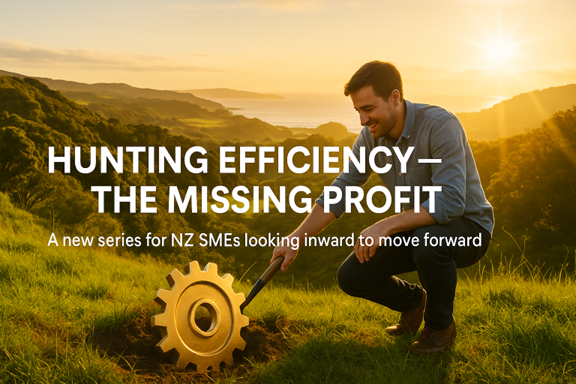19. Not All Customers Are Equal Segmenting for Profitability
A series about business efficiency, finding profit and how to get there
Introduction
Most SMEs pride themselves on great service. “We look after all our customers the same.” It’s said with conviction and good intention.But here’s the truth. Treating every customer the same can quietly erode your profitability, stretch your team too thin and prevent you from focusing on the clients that actually grow your business.
Because not all customers are equal.
Some buy more, pay faster, refer often and work with your process. Others haggle, delay payment and demand exceptions that cost you time and margin.
Segmenting your customers - not just by size, but by profitability, behaviour and strategic fit - allows you to focus your energy and service levels in a way that’s fair, sustainable and smart.
This isn’t about serving less - it’s about serving better.
Actions to Be Taken
Here’s how to segment your customer base for insight, efficiency and impact.Analyse Customer Profitability
Run a simple report that shows -
Total revenue per customer
Gross margin per customer
Average time spent servicing them
Payment timeliness
Repeat business/referral activity
You’ll quickly see which customers give the most and which ones take the most.
Create Segments Based on Value and Behaviour
Group customers into 3–5 segments. For example -
High-value, high-fit – aligned with your model, high margins, great relationships
High-maintenance, low-margin – time-consuming, low return
Growth potential – smaller now, but scalable
Legacy clients – long-standing but no longer aligned
Give each segment a “service level strategy” -
Who gets premium access or custom work?
Who gets automated updates only?
Who should be reconsidered for continued engagement?
Define Your Ideal Customer Profile (ICP)
List the characteristics of customers that -
Are easy to work with
Fit your delivery model
Pay promptly
Value your expertise
Stay with you long term
This becomes your targeting compass for future marketing, sales and referrals.
Adjust Pricing or Service Accordingly
Some customers will need to be repriced based on their real cost-to-serve. Others may require a boundary-setting conversation.
This can feel uncomfortable, but it’s far less damaging than letting profitable clients slip through the cracks while you chase volume that doesn’t serve you.
Psychological Perspective
Many SME owners struggle with the idea of “favouring” certain customers. It feels disloyal. Unfair. Like turning your back on the people who “got you here.”
But equity isn’t sameness. It’s about giving each customer the right level of service for the value and fit they bring.
When you over-service low-margin customers out of guilt or habit, you’re robbing your best clients and your team of the attention they deserve.
This shift requires boundaries, confidence and trust in your value. It’s not rejection. It’s realignment.
HR Best Practice
Poor customer segmentation shows up in team performance and morale.
Staff get overwhelmed serving clients who don’t fit. Frustration builds. Expectations get blurred. Burnout increases.
HR can support by -
Encouraging cross-team workshops on customer pain points
Training frontline staff to identify “ideal fit” indicators
Supporting teams in saying “no” or “not like that” when customer demands aren’t aligned
Protecting high-performing staff from being burned out by low-fit clients
Also track customer impact in staff feedback - who drains energy and who lifts it.
Red Flags to Watch For and Mitigate Against
You may need to re-segment if -
Your biggest clients are not your most profitable
Frontline staff complain about specific accounts constantly
You customise too much for too many
High-paying customers are getting the same response times as low-value ones
You feel emotionally attached to legacy clients who no longer make business sense
Segmenting helps you lead with clarity, not emotion.
Narrative Story
Meet Aroha from New Plymouth
Aroha runs a successful graphic design studio. For years, she served a mix of small local clients and larger national brands. But she realised the local jobs, though familiar, often undercut pricing, demanded constant revisions and paid late.
So she did a client segmentation review -
Grouped clients by size, industry and margin
Created a new pricing tier for “custom/complex” clients
Phased out several legacy clients who no longer fit
Doubled down on attracting aligned, scalable contracts
Within six months, revenue held steady - but profit improved by 22% and her team reported significantly less stress.
Her insight - “Once we got clear on who we serve best, everything else started clicking into place.”
Golden Nugget
The most profitable businesses don’t serve the most customers — they serve the right ones, the right way.
If you’d like a confidential, free of charge, free of obligation conversation about your business, here’s how to get me.
📞 Phone +64 275 665 682
✉️ Email john.luxton@regenerationhq.co.nz
🌐 Contact Form www.regenerationhq.co.nz/contact
If you’d like to read more RegenerationHQ thinking on SME business and other things, go here – www.regenerationhq.co.nz/articlesoverview
🔹 RegenerationHQ Ltd - Business Problems Solved Sensibly.
Supporting NZ SME Owners to Exit Well, Lead Better and Build Business Value.

